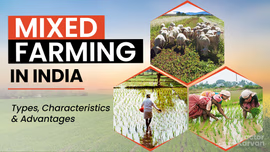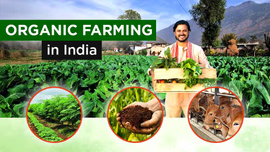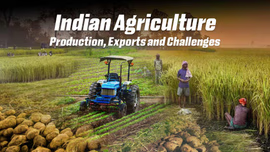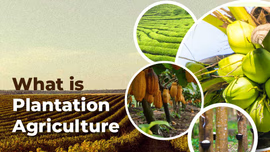Monoculture Farming in India: Its Advantages and Disadvantages

Monoculture farming cultivates a single type of crop over the entire land at a given time. Some of the popular monoculture crops grown in India are soybean, maize and wheat. Monoculture farming is large-scale and thus is known for higher output.
Table of Contents
- What is Monoculture?
- Advantages of Monoculture Farming
- Disadvantages of Monoculture Farming
- Sustainable Alternatives to Monoculture Farming
- Monoculture Farming in the Indian Context
What is Monoculture?
Monoculture is a farming method that involves growing a single crop type on a particular land at a specific time. Farmers plant the same crop in the same patch of land with minimal variation or crop rotation. The difference between monocropping and monoculture is that the former method involves growing a particular crop on the same piece of land every year.
On the other hand, if the farmer changes the crop type on the same land in different seasons, it would still be called monoculture farming. Simply put, it is the opposite of polyculture farming, where multiple crops are grown at a given time.
Monoculture farming is large-scale and thus is known for higher output. Increased productivity means more profit for farmers. Monoculture examples include seed crops like soybean, millet and sunflower, grains like maize, barley, rice and wheat and cash crops like sugarcane and cotton.
Advantages of Monoculture Farming
Monoculture farming is one of the most common farming practices in India. Here are the key advantages of monoculture farming:
- High Productivity: Farmers can maximize production and achieve high yields by concentrating efforts on a single crop. Monoculture farming facilitates the use of uniform cultivation practices, crop protection measures, and improved genetics, which contribute to increased crop productivity.
- Promotes Mechanization: Monoculture farming involves large-scale cultivation of crops. Thus, using machines, modern equipment and advanced irrigation practices to increase productivity is quite evident. New technologies like drone spraying are being employed to improve the quality of agricultural products.
- More Income: A single crop across vast areas of land results in higher crop production. Also, farmers generally grow crops that attract high demand and price, such as grains and cash crops. Food processing companies collaborate with such farmers to produce crops they need for their products. Higher revenue can be generated through such collaboration.
- Simplicity: Monoculture farming offers farmers ease of farming. Crop management becomes simple as only one type of crop has to be managed. Distribution of fertilizers, pesticides, and water becomes easy as the needs of crops are the same across the entire field.
Disadvantages of Monoculture Farming
Monoculture farming comes with a wide range of issues that endanger sustainable agriculture. The following are the major monoculture disadvantages:
- Soil Degradation: A crop demands specific nutrients for healthy growth. Continuous cultivation of a single crop can deplete soil nutrients, disrupt soil structure, and increase the risk of erosion. Monoculture farming often relies on chemical inputs, which can lead to soil degradation, loss of organic matter, and reduced long-term soil fertility.
- Extensive Use of Chemicals: Monoculture farmers are heavily dependent on chemical fertilizers and pesticides to manage diseases, insects and pests. Pesticides impact the environment in a negative way, especially if they are overused. They can pollute water and soil, harm birds and insects and contribute to air pollution. Overuse of fertilizers also leads to environmental damage, mainly due to its contribution to eutrophication.
- Biodiversity Loss: Monoculture farming results in biodiversity loss by replacing diverse ecosystems with uniform crop areas. Large fields do not allow local animal and plant species to flourish. This loss of biodiversity affects pollinators, beneficial insects, and other organisms vital for maintaining ecological balance and resilience.
- Economic Risk: Monoculture farmers are dependent on market conditions like the price of a single crop. If the price drops due to market fluctuations, they can lose a huge amount of money. Also, environmental conditions can result in lower yield. This is why polyculture is recommended so that farmers can depend on multiple crops at the same time.
Sustainable Alternatives to Monoculture Farming
Monoculture farming has resulted in severe degradation of soil and environment. Also, paddy and wheat demand huge amounts of water, leading to a shortage of groundwater levels. This is why the government has been promoting a number of initiatives to encourage sustainable farming.
Agroforestry
Agroforestry combines trees or perennial plants with crops or livestock. It promotes biodiversity, conserves soil and water resources, and provides additional income through timber, fruits and medicinal plants. Agroforestry systems protect ecological systems and contribute to sustainable agriculture.
Crop Rotation
Crop rotation involves the sequential cultivation of different crops on the same land. It helps break pest and disease cycles, improves soil health, and enhances nutrient management. Crop rotation promotes biodiversity, reduces the reliance on chemical inputs, and fosters a more sustainable farming system.
Polyculture
Polyculture farming involves cultivating multiple crops together in the same field. It mimics natural ecosystems, increases biodiversity, and reduces pest and disease risks. Polyculture farming can enhance nutrient cycling, improve soil fertility and provide diverse food sources.
Conservation Agriculture
Conservation agriculture emphasizes minimal soil disturbance, permanent soil cover, and crop diversification. It promotes soil conservation, improves water efficiency, and enhances carbon sequestration. Conservation agriculture practices contribute to sustainable land management and resistance in the face of weather change.
Organic Farming
Instead of chemicals, organic farming relies on organic manure for fertilizing fields. This sustainable practice can be used in the form of biological pest control. It enhances soil health, preserves biodiversity, reduces chemical pollution and produces healthier food products.
Monoculture Farming in the Indian Context
Monoculture farming is not a new concept for Indian farmers. In the 19th century, this farming practice was used in large plantations of cash crops, including rubber, coffee and tea. As the food demands of the population grew, the government started to focus on monoculture farming.
The Green Revolution led to a massive boost towards the adoption of monoculture. Farmers were encouraged to grow high-yielding varieties of crops like rice and wheat. Modern farming practices were promoted to improve agricultural productivity. These practices included the rampant use of machinery, pesticides and chemical fertilizers.
Monoculture plantations are common in Madhya Pradesh and Punjab. Wheat is the major crop sown in these states. Assam and Kerala also have farmers engaged in monoculture farming as these states receive heavy rainfall. The Indian government has been promoting sustainable agriculture practices as the adverse effects of monoculture farming have become evident, including environmental pollution, water depletion, and soil degradation.
Sustainable alternatives can enhance soil health and biodiversity and ensure long-term agricultural productivity. Farmers can contribute to a more sustainable future and reduce the negative environmental impact of monoculture farming.
Frequently Asked Questions On Monoculture Farming in India: Its Advantages and Disadvantages
1. What is monoculture?
Monoculture involves growing a single crop type on a particular land at one time.
2. What are the problems with monoculture farming?
The problems with monoculture farming include soil degradation, biodiversity loss, higher use of chemicals and economic risk.
3. How does monoculture cause soil erosion?
As monoculture farming grows only a single crop, it depletes specific nutrients from the soil. It makes the soil infertile and barren, resulting in soil erosion.
4. What are the benefits of monoculture farming?
The benefits of monoculture farming include high productivity, mechanization, ease of farming and more income.
5. What is an example of a monoculture?
Examples of monoculture crops include seed crops like soybean, millet and sunflower, cash crops like sugarcane and cotton and grains like maize, barley, rice and wheat.


Related Blogs












